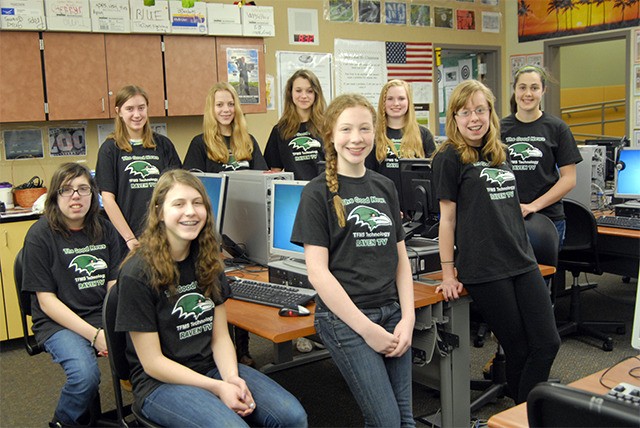Raven TV at Twin Falls Middle School is pretty cool, but the President of the United States is not likely to sit down and watch an episode. The guy just doesn’t have time to watch a lot of TV. On Friday, Feb. 28, though, he freed up an afternoon, to watch a different Twin Falls production.
“Now They Have a Chance,” a three-minute video by Twin Falls, is in the lineup of the first-ever White House Youth Film Festival. The 10 girls on the video team, all of them Tech Team members, found out after returning from mid-winter break that they received an Honorable Mention for their work.
What that means is “We didn’t get invited to the White House, because that would have been (for) the best, and just a couple of groups got invited,” said video team member Jessica Stringer, “but we got put on the website, and we’re in the film festival.” None of the girls seemed disappointed; Honorable Mention in a contest with thousands of entries is a great achievement, especially for the team’s first try at a competition.
Besides, “I think the President is going to watch this, which will be really cool!” said Mallory Golic, also on the team.
The White House Film Festival is a national competition, inviting students K-12 to create a video on how technology is used in schools. The girls, nearly all eighth grade Tech Team members who, as teacher Jana Mabry puts it, “grew up with (technology). They don’t fear it any more. They are at the perfect stage to blossom,” had been working on several technology projects, plus the monthly episodes of Raven TV featuring school values and announcements, and couldn’t decide what to film, at first.
“We were running all over the school, filming everything,” Golic said.
One project soon stood out, though, their work with Dillen Fullagar. Their sixth-grade classmate is in a wheelchair and didn’t have the manual dexterity he needed to create an Egyptian artifact, required for his class’s Egypt Walk at the end of January. The team helped Fullagar, who can use a computer without difficulty, take his digital design of an obelisk from computer file to physical reality with the school’s new three-dimensional printer, which sounds a lot easier than it was.
Mabry explained that the printer was ordered in November, after the school received a grant, but it didn’t arrive until January 2. The Egypt Walk was Jan. 30. Once it arrived, the team had trouble getting Fullagar’s file loaded, until just days before the event.
In the video, Fullagar says working with the MakerBot printer was “fantabulous and it gives kids like me a chance!”
“How does the technology help me participate? Well, it allows me to participate is a better answer,” he continues. “Without it, I might be seeing an F in the grade book, or my parents would have to be doing it for me.”
Mount Si High School graduate Dominique Seaman was also featured in the video, describing her experience of being hospitalized after a surgery, but still being able to collaborate with her class through video phone calls. High school teacher Joe Dockery’s class interviewed and filmed Seaman for this part of the video, and the Twin Falls team incorporated the footage that worked best for their project.
It was a bit of a scramble. “We had less than a month to do it,” says Grace Himka, “but we actually did it all in a week and a half.”
Working during school and after school—“toward the end we didn’t even care if only one of us could stay late,” Golic said—the girls did everything from choosing a topic, to shooting the video, interviewing and re-interviewing Fullagar—they wanted to ask him different questions after editing the footage of Seaman’s interview, Golic said—editing the final product, adding music and credits, then adjusting the level of the music, and, maybe the hardest part of all, choosing a title.
“We knew we wanted to say they have a chance,” said Stringer, but they frequently changed their minds on the best wording.
They also knew right away that they didn’t want themselves to feature in the video, except in the opening narration. The video shows Fullagar repeating the questions he’s asked before answering them, which the girls asked him to do.
“I think it’s better that it was just him,” said Kaila Nilsson.
Fullagar’s participation made the video possible, and his already-announced goal of joining the same team that helped him complete a school project gives the entire effort a circular nature.
“One of the neatest things of this whole project was Dillen saying ‘You know, everybody involved learned something,’” said Mabry.
As the opening narration of the video says, “These are smart kids, but because of their disabilities, they could not take advantage of the same opportunities as other students. Now they can. Now they have a chance.”

Courtesy photo
Twin Falls student Dillen Fullagar talks on camera about how technology made it possible for him to complete a class assignment, building an artifact for the sixth grade class’s Museum Walk last month. He used the school’s 3-D printer to create an Egyptian obelisk, with help from the Twin Falls student Tech Team and staff.


